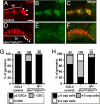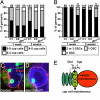Insulin levels control female germline stem cell maintenance via the niche in Drosophila
- PMID: 19136634
- PMCID: PMC2633547
- DOI: 10.1073/pnas.0809144106
Insulin levels control female germline stem cell maintenance via the niche in Drosophila
Abstract
Stem cell maintenance depends on local signals provided by specialized microenvironments, or niches, in which they reside. The potential role of systemic factors in stem cell maintenance, however, has remained largely unexplored. Here, we show that insulin signaling integrates the effects of diet and age on germline stem cell (GSC) maintenance through the dual regulation of cap cell number (via Notch signaling) and cap cell-GSC interaction (via E-cadherin) and that the normal process of GSC and niche cell loss that occurs with age can be suppressed by increased levels of insulin-like peptides. These results underscore the importance of systemic factors for the regulation of stem cell niches and, thereby, of stem cell numbers.
Conflict of interest statement
The authors declare no conflict of interest.
Figures






References
-
- Li L, Xie T. Stem cell niche: Structure and function. Annu Rev Cell Dev Biol. 2005;21:605–631. - PubMed
-
- Jones DL, Wagers AJ. No place like home: Anatomy and function of the stem cell niche. Nat Rev Mol Cell Biol. 2008;9:11–21. - PubMed
-
- Pan L, et al. Stem cell aging is controlled both intrinsically and extrinsically in the Drosophila ovary. Cell Stem Cell. 2007;1:458–469. - PubMed
-
- Boyle M, Wong C, Rocha M, Jones DL. Decline in self-renewal factors contributes to aging of the stem cell niche in the Drosophila testis. Cell Stem Cell. 2007;1:470–478. - PubMed
Publication types
MeSH terms
Substances
Grants and funding
LinkOut - more resources
Full Text Sources
Other Literature Sources
Medical
Molecular Biology Databases
Research Materials
Miscellaneous

